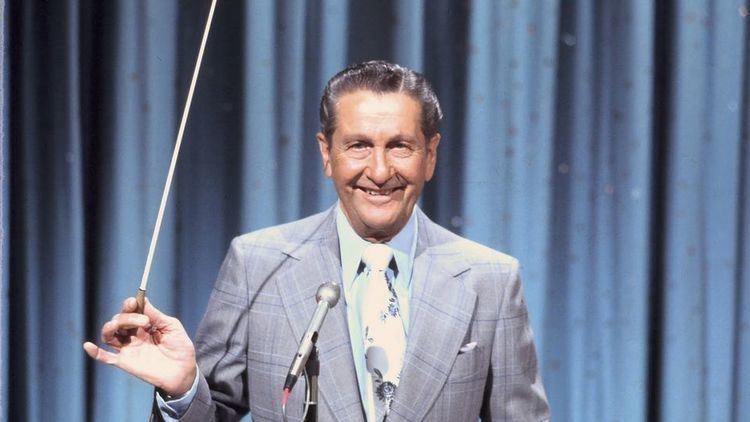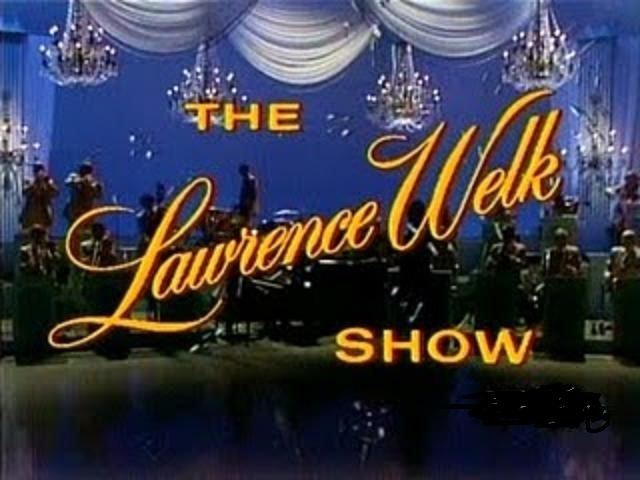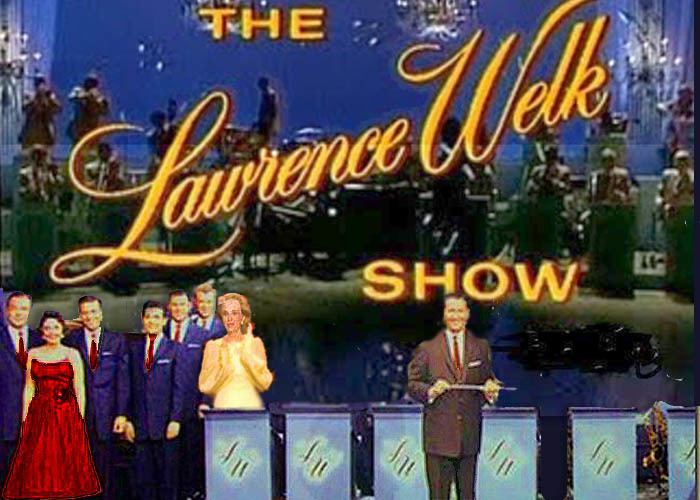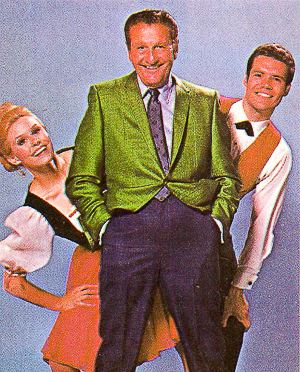4.4 /10 2 Votes
8.4/10 TV Country of origin United States Running time 60 minutes Final episode date 17 April 1982 | 7/10 IMDb No. of episodes 1065 First episode date 2 July 1955 | |||||||||||||||||||||||||||||||||
 | ||||||||||||||||||||||||||||||||||
Starring Myron FlorenBobby BurgessNorma ZimmerDick DaleThe Lennon SistersArthur DuncanJoe FeeneyJack ImelDave EdwardsSandi GriffithsTanya FalanAva BarberRalna EnglishGuy HovisGail FarrellMary Lou MetzgerNatalie NevinsAnacaniBob RalstonAmong many others Production company(s) KTLA (1951–1955)Teleklew Productions (1955–1982)American Broadcasting Company (1955–1971) Cast | ||||||||||||||||||||||||||||||||||
The lawrence welk show 200 years of american music part 1 01 17 1976
The Lawrence Welk Show is an American televised musical variety show hosted by big band leader Lawrence Welk. The series aired locally in Los Angeles for four years, from 1951 to 1955, then nationally for another 27 years on ABC from 1955 to 1971, and in first-run syndication from 1971 to 1982. In the years since first-run syndication ended, The Lawrence Welk Show has continued to reach new audiences through repeat episodes, broadcast in the United States by Public Broadcasting Service (PBS) stations. These airings incorporate an original program—usually, a color broadcast from 1965 through 1982—in its entirety. In place of the commercials, newer performance and interview clips from the original stars and/or a family member of the performers are included; these clips are occasionally updated.
Contents
- The lawrence welk show 200 years of american music part 1 01 17 1976
- The lawrence welk show big band splash host doc severinsen 03 05 2011
- Broadcast history
- Move to syndication and public television
- Nielsen ratings
- Format
- The Musical Family
- Producers and directors
- Episode status
- DVD status and Welk specials aired on public television
- In music
- In television
- In literature
- In movies
- Singers and performers
- The orchestra
- Announcers
- References

The lawrence welk show big band splash host doc severinsen 03 05 2011
Broadcast history

On May 11, 1951, The Lawrence Welk Show began as a local program on KTLA in Los Angeles, the flagship station of the Paramount Television Network and the first television station in California. The original show was broadcast from the since-demolished Aragon Ballroom at Venice Beach.

The show made its national television debut on ABC Television on July 2, 1955, and was initially produced at the Hollywood Palladium, moving to the ABC studios at Prospect and Talmadge in Hollywood shortly afterwards. For 23 of its 27 years on the air, the show would originate there. The only seasons not produced there were 1965–66, 1976–77 at the Hollywood Palace and CBS Television City from 1977 to 1979.

The 1965-66 season was taped at The Hollywood Palace because that was ABC's only West Coast TV studio at the time equipped for live or taped color production; Welk had insisted that the show go color in 1965 because he believed that being broadcast in color was critical to the continued success of his program. Once a couple of studios at the ABC Prospect and Talmadge facilities had been converted to color in 1966, the show moved back there.

The show aired on ABC until 1971. When the show was cancelled by the head of programming there, Welk formed his own production company and continued airing the show, on local stations and, often from 7 to 8 P.M. Eastern time on Saturdays over some of the ABC affiliates on which he had previously appeared, along with some stations affiliated with other networks. The syndicated version of the program aired from 1971 to 1982.
When the show debuted nationwide, The Lawrence Welk Show was billed as the Dodge Dancing Party in 1955 and 1956. During 1956–59, Lawrence Welk was broadcast two nights per week. The second show's title was Lawrence Welk Presents Top Tunes and New Talent (1956–58) and then Lawrence Welk's Plymouth Show, after another Chrysler vehicle (1958–59). The Plymouth show was the first American television program to air in stereophonic sound. Due to the fact that stereophonic television had not yet been invented (it would be 25 more years before it would become standard), ABC instead simulcast the show on its radio network, with the TV side airing one audio channel and the radio side airing the other; viewers would tune in both the TV and the radio to achieve the stereophonic effect. Starting with the 1959–60 season the two shows were merged into The Lawrence Welk Show, reverting to monophonic broadcasts. The name stuck, and it became the most popular variety show ever.
The primary sponsor of The Lawrence Welk Show was Dodge (automobile maker), later to be followed by Geritol (a multivitamin), Sominex (sleep aid), Aqua Velva (aftershave), Serutan (laxative), Universal Appliances (manufacturer of home appliances), Polident (a denture cleanser), Ocean Spray (fruit juice) and Sinclair Oil (automobile fuel) served as associate sponsors for a short time. (During later years, a number of Welk cast members appeared in commercials for many of the show's sponsors, filmed specifically to air during Welk broadcasts.)
Move to syndication and public television
While the show was highly rated and continued to attract more audiences, ABC canceled it in 1971 for two reasons. The first was that the network had to cut three and a half hours a week of prime-time programming owing to the institution of the Prime Time Access Rule in 1971; the other was the fact that Welk's viewership was mostly of people over forty-five, mostly because of the music he chose to play, but also because younger viewers, the core viewing target that networks coveted, were either out during the Saturday night time slot, or were watching one of the other networks. Over the course of the early 1970s, several variety shows (including Welk's, but ranging from long-running series such as The Ed Sullivan Show, The Hollywood Palace and The Red Skelton Show to more contemporary shows such as Hee Haw, The Johnny Cash Show and This Is Tom Jones) were pulled from network schedules (particularly ABC and CBS) in a demographic move known colloquially as the "rural purge".
In response to ABC's move, Welk started his own production company and continued producing the show for syndication. Some independent stations put it in its old Saturday timeslot, and in many cases, it drew higher ratings than the network shows scheduled at that time. In many markets, the syndicated Lawrence Welk aired before the start of network prime-time on Saturday nights (7 p.m. Eastern Time); also in many areas, it competed against another show that was cancelled by CBS and resurrected in syndication, also in 1971 — Hee Haw. Welk's program was among a group of syndicated niche programs, others including Hee Haw and Soul Train, that flourished during this era. (The success of Lawrence Welk and Hee Haw in syndication and the network decisions that led to their respective cancellations were the inspiration for a novelty song called "The Lawrence Welk-Hee Haw Counter-Revolution Polka," performed by Roy Clark, one of the co-stars of Hee Haw.)
Welk retired in 1982; at the time of his retirement, he was 79 years old, making him the oldest host of a regularly scheduled entertainment television series to date (a feat later surpassed by Bob Barker in 2003 and later by Betty White in 2012). Classic shows — largely, from 1967 to 1982 — were repackaged with new footage (either Welk or the show's cast introducing segments) for syndication during the 1982–1983 season as Memories with Lawrence Welk, after which they were withdrawn from distribution for a short time. In 1985, The Lawrence Welk Christmas Reunion was produced. It was the last show in which Welk appeared with the musical family.
The Oklahoma Educational Television Authority acquired the broadcast rights to the series in 1986. In order to introduce the show to a new generation, they produced a documentary film, Lawrence Welk: Television's Music Man, hosted by Kathy Lennon of The Lennon Sisters. The film was a retrospective on Welk's life and career, featuring interviews with surviving members of Welk's "musical family", and scenes from the show. After its airing, reformatted versions of the Welk show were released to public television stations. Welk's segments from Memories with Lawrence Welk were used until his death, after which select members of the "musical family" took over as hosts. Reruns continue to air to this day (in many markets airing on Saturday nights at 7 pm, the same time the show aired during the latter years of its original run), with new and updated interviews with surviving cast members (Mary Lou Metzger hosts wraparounds that feature interviews, while Bobby Burgess currently hosts the ones that do not). The shows are occasionally "recut" and interspersed with segments from other episodes for time and diversity purposes; for instance, a rebroadcast of Gail Farrell's 1969 debut actually featured an added song by Anacani, who hadn't joined the show until 1973.
Nielsen ratings
The show was a Top 30 hit for five seasons, according to ClassicTVHits.com's ratings database.
Format
The show would often open by showing bubbles floating around and was accompanied by a sound effect of a bottle of champagne opening, including the opening theme ("Bubbles in the Wine," composed by Welk and Frank Loesser). Each week, Welk would introduce the theme of the show, which usually inspired joyous singing and/or patriotic fervor. He was most known for delivering these monologues in a distinctive German accent (this despite being born and raised in North Dakota), which was parodied in popular culture (even by Welk himself: the two books he authored, Wunnerful, Wunnerful! and Ah-One, Ah-Two! were so titled because they were his catchphrases). This was evident from his mispronunciations of script on cue cards. On one such story, related by Jo Ann Castle on the Mike Douglas Show, has him introducing a medley of World War I tunes as "songs from World War Eye". Also, from his autobiography Wunnerful, Wunnerful! he bemoans his accent, and in some of his pronunciations of "wonderful" in the show he can be heard forcing the D.
If the number was more of a dance tune, Welk would frequently dance with ladies from the audience, for which he became somewhat known. For certain songs (mainly the instrumentals performed by the orchestra), the couples in attendance were also allowed to dance at the Ballroom. Many of the show's songs were performed as part of a skit; while a handful of skits were common throughout the show's run, during a short period in mid-1970s (about the same time The Semonski Sisters were featured performers on the show), the show consisted almost entirely of them.
Welk often demonstrated multiple times on-camera how the champagne bottle sound was created, by placing a finger in his mouth, releasing it to make the popping sound, and making a soft hissing sound to simulate the bubbles escaping the bottle. One such instance is part of the opening sequence of the public television reruns seen today.
Welk frequently had performers sing and play standards from the big band era and the first half of the 20th century (Welk had a particular admiration for his contemporary composers, such as Hoagy Carmichael, Henry Mancini, Johnny Mercer, Cole Porter, and Harry Warren, among others), although the show's repertoire was in reality much broader and would often include pop songs from the 1950s, 1960s, and 1970s (Welk even devoted an entire show to the music of the 1970s in 1978) as well as country music, patriotic music, and religious music, especially if it was thought to appeal to older listeners (and, as Welk stated in 1956, "as long as it's done in the champagne style"). In one of his most infamous incidents, he asked singers Gail Farrell and Dick Dale to perform Brewer & Shipley's hit song "One Toke Over the Line" (a mock gospel tune riddled with drug references) as a modern spiritual, apparently oblivious to the meaning of the word "toke." Brewer responded that although it was "absurd," the duo "got more publicity than we could pay for" from the out-of-place performance. Welk, for his part, blamed ABC for pressuring him into including the song, among others he felt did not fit the show's format.
The closing theme during the syndicated years, often performed by the Musical Family, was "Adios, Au Revoir, Auf Wiedersehen" (composed by George Cates). A recording of the song has been edited over the updated credits on PBS reruns.
The "Musical Family"
Welk employed many musicians and singers, which were known in the press as his Musical Family. Most members of the Musical Family had specific, well-defined roles within the context of the show, generally specializing in one type of performance (for instance, the show had two pianists, but one would specialize in ragtime piano while the other would handle easy listening pieces; the show's numerous singers and dancers were similarly typecast). One of the most prominent positions in the Musical Family was the "Champagne Lady," who always sang a down-tempo solo number toward the end of each show.
These musicians were bound by an unofficial set of morals (artistic and personal) dictated by Welk, and if he believed the audience did not find them wholesome enough, they would be fired. Former Champagne Lady Alice Lon was fired in 1959 for crossing her legs on a desk, which angered Welk. After he fired Lon, thousands of letters filled the ABC mailroom, demanding an apology, and that she be rehired. Welk tried to get Lon back but she refused.
In later years however, it was revealed that along with the "cheesecake" incident, another one of the reasons for Lon's departure was money; she was supporting three young sons and wanted a raise. A further reason was a dispute over what kind of songs she would be singing, and since Welk insisted on playing what he felt his audiences wanted to hear, generally older "standards", she rebelled against such restrictions.
After two years and a string of short-lived vocalists, Norma Zimmer was hired, starting in 1960. Zimmer stayed with Welk for the rest of the show's run.
Another example of being bound by Welk's set of morals was famed clarinetist Pete Fountain, renowned for his New Orleans-style jazz. He was a valued member of the Welk cast who was rumored to have quit when Welk objected to his efforts to "jazz up" the Christmas standard "Silver Bells" on the 1958 Christmas show. In an interview, Fountain admitted he left Welk because "Champagne and bourbon don't mix." (The departure was amicable; Fountain would reappear in Welk reunion shows after the show ended.)
Welk relied on fan letters to tell him who was popular and who was not. Often, performers who received a positive reaction were prominently featured on future shows, while those who did not meet muster with the audience saw their solo opportunities diminish and sometimes were eventually let go.
Among the performers that were wildly popular with audiences during the years it was on ABC were The Lennon Sisters, Joe Feeney, Steve Smith, Larry Hooper, Jo Ann Castle and electric guitarist Buddy Merrill, just to name a few. Lynn Anderson, Clay Hart, and Ava Barber used the show as a springboard to launch their own successful careers as country music solo artists. At the height of the show's popularity, members of the Musical Family were featured in several celebrity tabloid magazines alongside other mainstream television and movie stars.
Tap dancer Arthur Duncan became the second African-American to appear regularly on a sponsored television variety program, and the first since 1951, when he was hired as a permanent music maker by Welk in 1964. (The first was Teddy Wilson, a regular band member on the short-lived Star Time throughout its 1950–51 run.)
Producers and directors
James Hobson (aka, Jim Hobson) served longest as producer (1962-1982) and director of The Lawrence Welk Show. Hobson died on April 26, 2013, in Santa Monica Hospital, California.
Episode status
The surviving episodes from the first 10 seasons on ABC, which began in 1955, exist today as black and white kinescopes or videotape, as the show was broadcast live for the first 10 years, right up through the 1964–1965 season. A few of these have been broadcast on public television. Nearly all episodes shown on PBS stations today are from around 1965 to 1982 (the majority being from the syndicated run), but some older black and white segments can be found on YouTube and in recent months more black-and-white episodes have been added into the rotation.
Beginning with the 1965–1966 season, the episodes were recorded in color. It is assumed the color episodes exist intact. The very first color episode of the show, which aired in September 1965, was taped on-location at the Escondido resort near San Diego that Welk had a financial and ownership interest in. It's occasionally shown on PBS stations and the PBS rebroadcast is introduced by Bobby Burgess.
DVD status and Welk specials aired on public television
Neither the Welk Organization nor the OETA have released any episodes of The Lawrence Welk Show on home video, nor are there any plans to do so. Welk Musical Family specials, however, are available on DVD, and can be obtained with a donation during reairs on local PBS stations.
In music
In television
In literature
In movies
Singers and performers
All of these singers and performers were part of the Music Family, with Welk on the lead.
The orchestra
Rose Weiss was the long-term Welk costume designer and manager.
